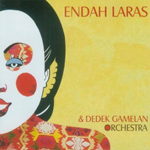|
|
 |
Dusted Reviews
Artist: Endah Laras & Dedek Gamelan Ensemble Album: Endah Laras & Dedek Gamelan Ensemble Label: Felmay Review date: Jul. 18, 2012 |

|
|
|
 |
Ask most semi-adventurous music fans, and they’ll be able to identify the sound of a gamelan ensemble. But include the particular strains of gamelan composition, and the different styles of music that pepper Indonesia, defined by region, ethnicity, or era? I’d assume that the number of raised hands would dwindle quite a bit, mine included. The complicated nature of Indonesian gamelan is part of what makes this self-titled collaboration between vocalist Endah Larah and composer Dedek Wahyudi such a rich listening experience. The disc’s spanning of geography and chronology provides a bevy of different settings, both traditional and modern, in which to spotlight Laras’s singing. And no matter the music behind her, it’s Laras’s voice that is unquestionably the featured instrument on every track.
The album begins and ends with solo performances written and sung by Laras, unaccompanied showcases of her evocative and supple voice. On the tracks between “Gandrung Temenan” and “Isih Tresno,” Wahyudi and Laras work in a variety of idioms, sometimes straightforwardly presenting a folksong, sometimes combining Javanese, Sundanese and Balinese gamelan conventions into a 21st century hybrid. Even to the uneducated ear, the differences can be stark. There are tracks of fast-paced, intricate rhythm, their melodies climbing and descending along winding paths, but also tracks on which the instrumental accompaniment is minimal to the point of near silence. A pair of the album’s selections feature Laras’s adaptation of texts from macapat, a form of Javanese poetry. Wahyudi’s orchestration is so quiet as to be almost unnoticeable, especially on “Macapat Sinom Slendro,” where Laras, singing with clarity and confidence, is accompanied by music so subtle that it is more a suggestion of sound than actual notes by the time it hits the ear. Wholly different are the Kronkong pieces near the album’s conclusion. The style, originally the product of 16th century Portuguese colonists’ assimilation into Indonesian culture, has an obvious Western influence. Sung in duet form with a ukulele the only instrumental addition, the Kronkong songs combine Polynesian flavor with an old-timey Iberian flair. Laras acquits herself quite capably, no matter the style, from the Eurasian fusion of “Kronkong Kemayoran” to “Lindri,” a culture-crossing medley of children’s songs from Central Java.
Many of Laras and Wahyudi’s modernizations and combinations will undoubtedly go unnoticed by most listeners. Liner notes by the disc’s producer, John Noise Manis, detail the music’s ingredients and inspiration, but one needn’t be an attentive student of Indonesian music to find enjoyment in the album. The tinges of Western influence make the album more approachable, and don’t cheapen or dilute the music (save for the unexpected inclusion of Big Ben’s famous chimes at the beginning of “Lindri”). Both Wahyudi and Laras appear to have a respect for history and a thirst for finding new ways to work with traditions that, in some cases, are centuries old. There may be moments on the album that will give traditionalists reason to turn up their nose, but that needn’t lessen the album’s enchantment for the rest of us.
By Adam Strohm
|







